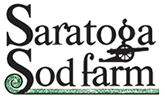Not all grass is created equal. There are about a dozen different types of grass and most lawns consist of a mixture of them. A great example of different grass types can be found on golf courses or athletic fields.
Grass types in the U.S. will typically fall into one of these two categories: Warm Season or Cool Season. It’s important to know how to identify types of grasses for proper care and maintenance as well as if you are looking for sod for a new lawn installation.
In this article, we’ll share with you how to identify your grass. We’ve also included a list of the top 10 types of grass and which are warm-season or cool-season grasses. Then discover the three northern grass varieties Saratoga Sod offers!
How to Identify Types of Grass
Your grass consists of several identifiable properties that can help you determine the type of grass you have.
- Grass blade shape and size – grass blades can be tall and thin or short and wide, and average blade widths vary between types.
- Grass color and texture – grass colors can range from yellow-green to dark, lush green. Textures could be any degree between rough and smooth.
- Growth height and speed – your grass may grow fast and grow tall, while others may stay short and take longer to grow.
- Where you live – depending on what region you are in, your grass type will be specific to your climate (i.e. warm, cold, wet, dry) and your soil (clay, sandy, silty, peaty, loamy).
- Water Requirements – depending on your grass type, it may do well in wet conditions but is not drought-resistant, or your lawn could withstand drought-like conditions but not do well in extreme shade or wet areas.
- Maintenance level – does your grass require regular weed control, frequent mowings, or watering? The type of grass you have will determine the amount of maintenance it requires.
Some types grow better in certain climates than other ones and therefore require different maintenance routines. Turfgrass sod can be separated into two types: warm season and cool season.
List of 10 Common Warm and Cool Season Turf Grasses
Warm-season grasses, as the name suggests, thrive best during hot weather seasons and are ideal for areas in the south.
Top 5 Warm Season Grass Types:
- Bahia
- Bermuda
- Zoysia
- Centipede
- St. Augustine
Cool-season turf grasses are mostly grown in northern areas that have a cooler climate year-round. When these grasses are exposed to extreme heat or drought, they become dormant if not adequately watered. This is especially true for newly planted sod, which requires sufficient daily watering post-installation, until properly rooted.
Top 5 Cool Season Grass Types:
- Kentucky Bluegrass
- Perennial Ryegrass
- Fine Fescues (Creeping Red, Chewings, Hard)
- Turf Type Tall Fescue
- Creeping Bentgrass
The Best Cool Season Turfgrass Sod Available at Saratoga Sod
At Saratoga Sod, we grow a variety of northern turfgrass blends and mixtures, each with unique traits, perfect for different site conditions:
-
Kentucky Bluegrass
Kentucky bluegrass is one of the most popular northern turfgrass species. It has a deep, green color and excellent texture, and grows from a very extensive system of rhizomes, underground stems that produce new plants. However, it does not grow well in deep shade.
Common traits include:
- Blade Shape/Size: V-shaped, pointed, 1/8” wide
- Color/Texture: Darker green, soft
- Growth: Aggressive, via rhizomes
- Water: Average
- Popularity: Northern favorite, especially for well maintained lawns and high-use athletic fields
-
Fine Fescue/Bluegrass Mix
Kentucky bluegrass will form the nicest lawn, but it has a very low shade tolerance. Fescues (both tall and fine) are often found in mixes due to their tolerance to shade, cold, and drought. When combined correctly, these types will form a dense turf that is acceptable for most Northern lawns in the U.S.
Versatile, shade tolerant, and drought tolerant. A mix of two kinds of grass, this 50/50 mixture may be the sod of choice if you are installing next to an existing lawn or patching an area.
-
Turf Type Tall Fescue
Typically considered a cool-season grass, tall fescue can also be found in hotter regions due to its higher drought tolerance, which is due primarily to its deeper root system. Turf Type Tall Fescue is relatively low maintenance and handles traffic well, and is also relatively shade-tolerant. In lawns that are not predominately tall fescue, patches of tall fescue may stick out and appear as a grassy weed.
Common traits include:
- Blade Shape/Size: Pointed, visible veins, 3/16” wide
- Color/Texture: Dark green, coarse, stiff
- Growth: bunch-forming growth habit
- Water: Frequent
- Popularity: northern and transition zone climates
Whether you’re installing a home lawn, golf course, or a whole sports field, we’ve got you covered! All sod is available in small rolls on pallets (for residential projects) or Big Rolls (for large open areas such as sports fields and golf courses).
Saratoga Sod Farm is a proud grower, supplier, and installer of high-quality turfgrass sod to commercial and residential clients in NY & the Northeast. Get in touch with us today regarding pricing, installation services, or any questions about sod!


